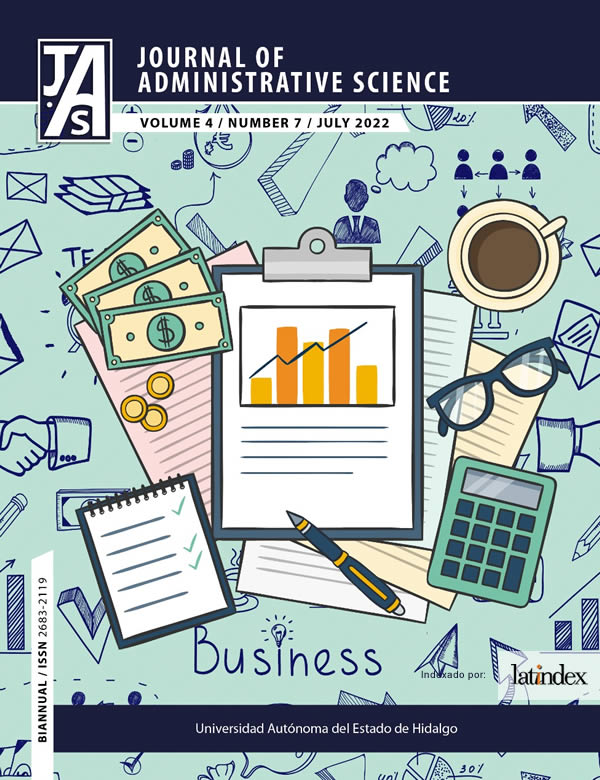E-commerce in the financial sector: transition to industry 4.0
DOI:
https://doi.org/10.29057/jas.v4i7.8768Keywords:
L-81 Elecctronic Commerce, O-33 Industry 4.0, L-80 Financial ServicesAbstract
The aim of the work consists of: identifying the e-commerce activities implemented by the financial sector in Mexico, using quantitative methods, in order to perform a cluster analysis. Through a compilation of data from the Census on information and communication technologies (2019), sales in millions of pesos and sales methods through ecommerce (Company website, third-party website) are established as study variables. , social media, email). The results indicate that the financial sector that operates in Mexico City reflects the highest amount of sales revenue through e-commerce in: the company's website, third-party website and email, while the sector predominates in social networks financial institution of Nuevo León. Challenges are observed in the integration of technologies industry 4.0 that allow generating greater competitiveness in digital marketing
Downloads
Publication Facts
Reviewer profiles N/A
Author statements
Indexed in
- Academic society
- N/A
- Publisher
- Universidad Autónoma del Estado de Hidalgo
References
Vega, J.M., Romero, S.A. y Guzmán, G. (2018). Marketing digital y las finanzas de las Pymes”. Revista de Investigación en Tecnologías de la Información. 6 (12), 100-106.
Chaffey, D., & Ellis-Chadwick, F. (2014). Marketing digital estrategia, implementación y práctica. México, D.F.: Pearson educación, 2014.
Czinkota, M. y Ronkainen, I. (2013). Marketing Internacional (10.a ed.). Ciudad de México: Cengage Learning Editores.
Ballesteros, L., Silva, F., Mena, D. y Angamarca, M. (2019). Estrategias de marketing digital en empresas E-commerce: un acercamiento a la perspectiva del consumidor”. Digital Publisher, 4 (5), 109-122. doi:10.33386/593dp.2019.5-1.
Asociación Mexicana de Ventas online [AMVO] (2020). Ventas online 2019. Disponible en https://www.amvo.org.mx/asociate
Durmaz, Y., & Halil Efendioglu, I. (2016). Travel from traditional marketing to digital marketing. Global Journal of Management and Business Research: E Marketing, 16(2), 1–8.
Erbes, A. (2019). Industria 4.0: oportunidades y desafíos para el desarrollo productivo de la provincia de Santa Fe, Documentos de Proyectos (LC/TS.2019/80), Santiago, Comisión Económica para América Latina y el Caribe (CEPAL).
Rodic, B. (2017). Industry 4.0 and the New Simulation Modelling Paradigm. Organizacija, 50(3), 193-207. doi: 10.1515/orga-2017-0017
Strange, R., y Zuchella, A. (2017). Industry 4.0, global value chains and international business. Multinational Business Review, 25 (3), 174-184.
Asociación Mexicana de la Industria de las Tecnologías de la Información [AMITI] (2016). Crafting the future
A roadmap for industry 4.0. Disponible en https://esemanal.mx/catalogo/asociacion-mexicanade-la-industria-de-tecnologias-de-informacion/
Ismail, M. Khater, M. y Zaki, M. (2017). Digital Business Transformation and Strategy: What Do We Know So Far?", Cambridge Service Alliance. Disponible en: https://cambridgeservicealliance.eng.cam.ac.uk/resou rces/Downloads/Monthly%20Papers/2017NovPaper_ Mari am.pdf.
Tao, F., Zuo, Y., Xu, L. y Zhang, L. (2014). Percepción inteligente basada en IoT y acceso de los recursos de fabricación hacia la fabricación en la nube, IEEE Transactions on Industrial Informatics , 10 (2), 1547–1557.
Maya, D (2019). Industria 4.0 en el sector financiero: estado actual y retos futuros. Tesis de Maestría, Universidad Nacional de Colombia.
Ríos, M. (2015). Análisis y perspectivas del comercio electrónico en México. Perfiles de las Ciencias Sociales, 3 (5), 1-27.
Grandon, E. y Pearson, M. (2004). Electronic commerce adoption: an empirical study of small and medium US businesses”, Information & Management, 42(1),197-216.
Bojórquez, M. J., Valdez, O. (2017). El comercio electrónico como estrategia de internacionalización de las pymes. RITI Journal, 5 (10), 110-115.
Ynzunza, C., Izar, J.M., Bocarando, J. G. (2017). El Entorno de la Industria 4.0: Implicaciones y Perspectivas Futuras Conciencia Tecnológica, 54, 1- 19.
Hong, W. y Zhu. K.(2006). Migrating to internetbased e-commerce: Factors affecting e-commerce adoption and migration at the firm level, Information & Management, 43(2), 204-221

















